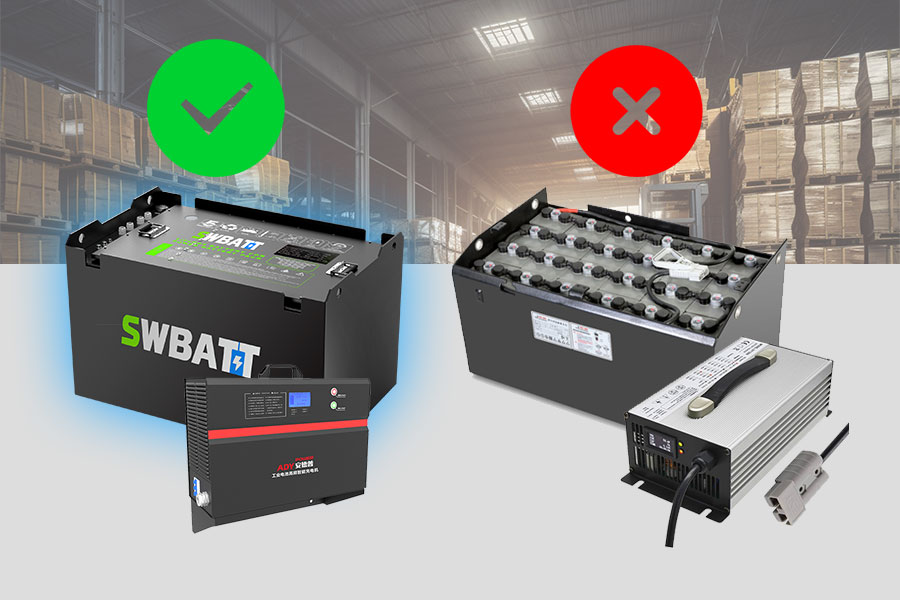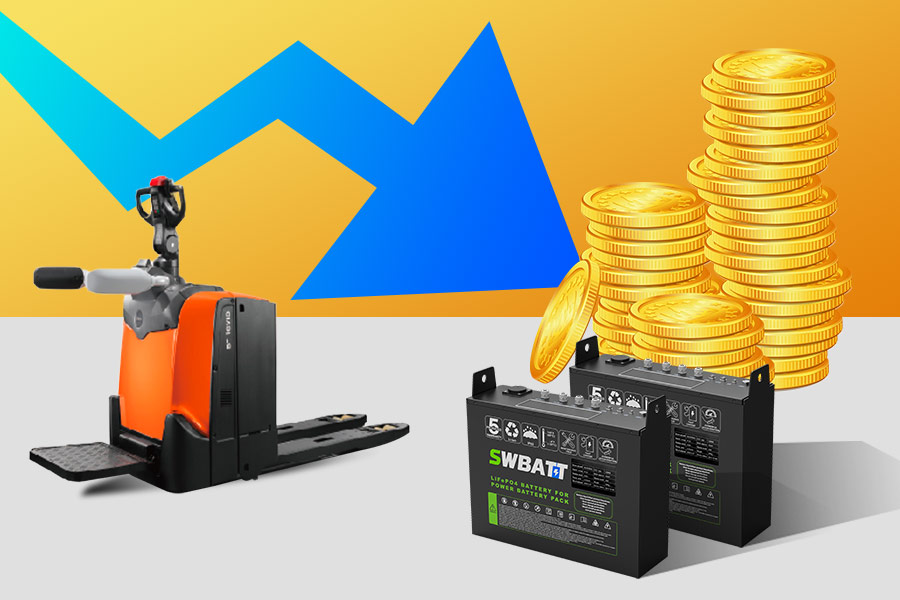Introduction
As a leading manufacturer of lithium-ion battery packs for electric forklifts, we understand that the forklift charger is just as crucial as the battery itself. It’s the vital link between your power grid and your fleet, directly impacting uptime, battery life, and overall operational efficiency. Choosing the correct charger isn’t just about plugging in; it’s a strategic decision that affects your bottom line.
This comprehensive guide is designed for B2B decision-makers—forklift dealers, brand owners, and fleet operators—who are navigating the world of electric forklift charging. We’ll cover everything from the basics of charger technology to the specifics of forklift charger connector types and the advantages of dedicated forklift charger station setups.
We’ll also provide a clear, data-backed comparison of charging solutions for traditional lead-acid batteries and the increasingly popular lithium-ion batteries. Our goal is to empower you with the knowledge you need to make informed decisions, whether you’re outfitting a new warehouse, upgrading an existing fleet, or simply seeking to optimize your charging processes. We are not simply providing chargers; we offer the best charging solution.
The Evolution of Forklift Charging: From Basic to Smart
Forklift charging technology has come a long way. Early chargers were simple, often inefficient, and offered limited control. Today, we have a range of options, from basic “dumb” chargers to sophisticated “smart” chargers with advanced features like:
- Multi-Voltage Capability: Chargers that can automatically detect and adjust to different battery voltages (24V, 36V, 48V, 80V).
- Multi-Chemistry Compatibility: Chargers designed to handle both lead-acid and lithium-ion batteries (though it’s crucial to ensure proper settings for each chemistry).
- Opportunity Charging: High-frequency chargers allow quick, partial charges during breaks and shift changes, maximizing uptime.
- Data Logging and Communication: Chargers that record charging data and can communicate with battery management systems (BMS) or fleet management software.
- Remote Monitoring and Control: The ability to monitor and control charging processes remotely, optimize energy usage, and identify potential problems.
Lead-Acid vs. Lithium-Ion Charging: Key Differences
While the fundamental goal of a forklift charger is the same – to replenish the battery’s energy – the charging requirements for lead-acid and lithium-ion batteries are significantly different. Understanding these differences is critical for ensuring battery safety, performance, and longevity.
| Особливість | Lead-Acid Charging | Lithium-Ion Charging | Source(s) & Notes |
| Algorithm | Multi-stage, Equalization needed | CC/CV, BMS Controlled | Battery University. Lithium is more precise. |
| Charge Time | 8-10 hrs + Cool-down | 1-3 hrs; Opportunity Charging | [Industry Standards]. Lithium charges much faster. |
| Opportunity Charging | Not Recommended | Highly Recommended | Battery University. Key advantage of lithium. |
| Equalization | Required Regularly | Not Required | OSHA, MHI. Saves time and labor. |
| Gassing | Significant | Мінімальний | NFPA. Lithium is safer. |
| Watering | Required | Not Required | [Manufacturer Specs]. Less maintenance with lithium. |
| Compatibility | Specific Lead-Acid Chargers | Specific Lithium-Ion Chargers | [Manufacturer Specs]. Crucial to use the correct charger. |
| Температура | Sensitive to Cold | Better Cold Performance | Battery University. Lithium is more versatile. |
| Charger Efficiency | Lower (70-85%) | Higher (90-98%) | Lithium solution is more efficient |
Discover Advanced Lithium Battery Solutions
Explore SWBATT‘s innovative LifePO4 batteries for electric vehicles, energy storage, and more. Tailored solutions to meet your energy needs with efficiency and sustainability.

Choosing the Right Forklift Charger: A Practical Guide
Selecting the correct forklift charger involves considering several factors:
- Battery Chemistry: Are you charging lead-acid or lithium-ion batteries? This is the most critical factor.
- Battery Voltage and Capacity: What is your forklift battery’s voltage (e.g., 24V, 36V, 48V, 80V) and capacity (Amp-hours, Ah)? The charger must be compatible.
- Charging Current: How quickly do you need to charge your batteries? Higher current chargers provide faster charging but may require a more robust electrical infrastructure.
- Number of Shifts: Do you operate one, two, or three shifts? This will influence your charging strategy (conventional charging vs. opportunity charging).
- Charging Environment: Will the chargers be located indoors or outdoors? What is the ambient temperature?
- Connectivity and Data: Do you need a “smart” charger with data logging, remote monitoring, or communication capabilities?
- Budget: Consider the initial purchase price and the long-term operating costs (energy efficiency, maintenance).
- Plug and Connector: Choose the correct forklift plug and charger connector types for seamless connection.
Understanding Forklift Charger Components and Accessories
Beyond the charger itself, several components and accessories play a crucial role in a safe and efficient charging setup:
- Forklift Charger Stand: This stand provides a stable and secure mounting location for the charger, keeping it off the floor and protecting it from damage.
- Forklift Charger Plug & Connector: This is the interface between the charger and the forklift battery. Common types include SB, SBX, Euro, and DIN connectors. Compatibility is crucial. Using the wrong forklift charger plug or connector can damage the battery and the charger.
- Forklift Charger Cable: The cable connecting the charger to the forklift battery must be appropriately sized for the charging current and have sufficient length.
- Forklift Charger Extension Cable: This cable extends the reach of the charging cable. Ensure it’s rated for the appropriate amperage and voltage.
- Forklift Charger Cable Retractor: This device keeps the charging cable organized and off the floor, preventing tripping hazards and cable damage.
- Forklift Charger Station: This provides sufficient power and space for charging and is often equipped with multiple charging ports, cable management systems, and safety features. It is important for high-utilization fleets.
The Advantages of a Dedicated Forklift Charger Station
For larger fleets or operations with multiple shifts, a dedicated forklift charger station offers several benefits:
- Centralized Charging: Provides a designated area for charging, improving organization and workflow.
- Optimized Space Utilization: Makes efficient use of floor space.
- Improved Safety: Reduces clutter and tripping hazards associated with scattered chargers and cables.
- Enhanced Battery Management: Facilitates opportunity charging and allows for better battery health monitoring.
- Scalability: This can be easily expanded to accommodate future growth.
Our Commitment to Quality and Innovation (Manufacturer Perspective) We provide a comprehensive charging solution, including different charging connectors, chargers for different battery voltages, and single/three-phase chargers.
Поширені запитання
1. Can I use the same forklift charger for lead-acid and lithium-ion batteries?
Answer: Only if it’s a specifically designed “multi-chemistry” charger and you correctly configure it for each battery type. Lithium requires precise CC/CV charging and BMS communication; using the wrong charger is dangerous and damages batteries. Always verify compatibility.
2. What’s the difference between conventional and opportunity charging, and which is better for my operation?
Answer: Conventional = Full discharge, then full recharge (typical for lead-acid). Opportunity = Top-up charging during breaks (ideal for lithium). Better choice depends: Single shift/low use = Conventional might suffice. Multi-shift/high use = Opportunity (lithium) is usually far more efficient.
3. How do I choose the correct forklift charger plug and connector?
Answer: Check your forklift and battery manuals for the exact connector type (e.g., SB50, SB175, SBX, Euro, DIN). Using the wrong connector can be a safety hazard and damage equipment. If you are unsure, contact your dealer/supplier. We can help you select the appropriate charger connector.
Conclusion: Powering Your Fleet’s Success
У "The forklift charger is a critical component of your electric forklift operation. Choosing the proper charger, understanding the differences between lead-acid and lithium-ion charging requirements, and implementing best practices for charging management will directly impact your fleet’s productivity, safety, and long-term cost-effectiveness. We hope to empower you to make informed decisions and optimize your charging strategy by providing this comprehensive guide. We are glad to be your partner in lithium battery and charging solutions.




